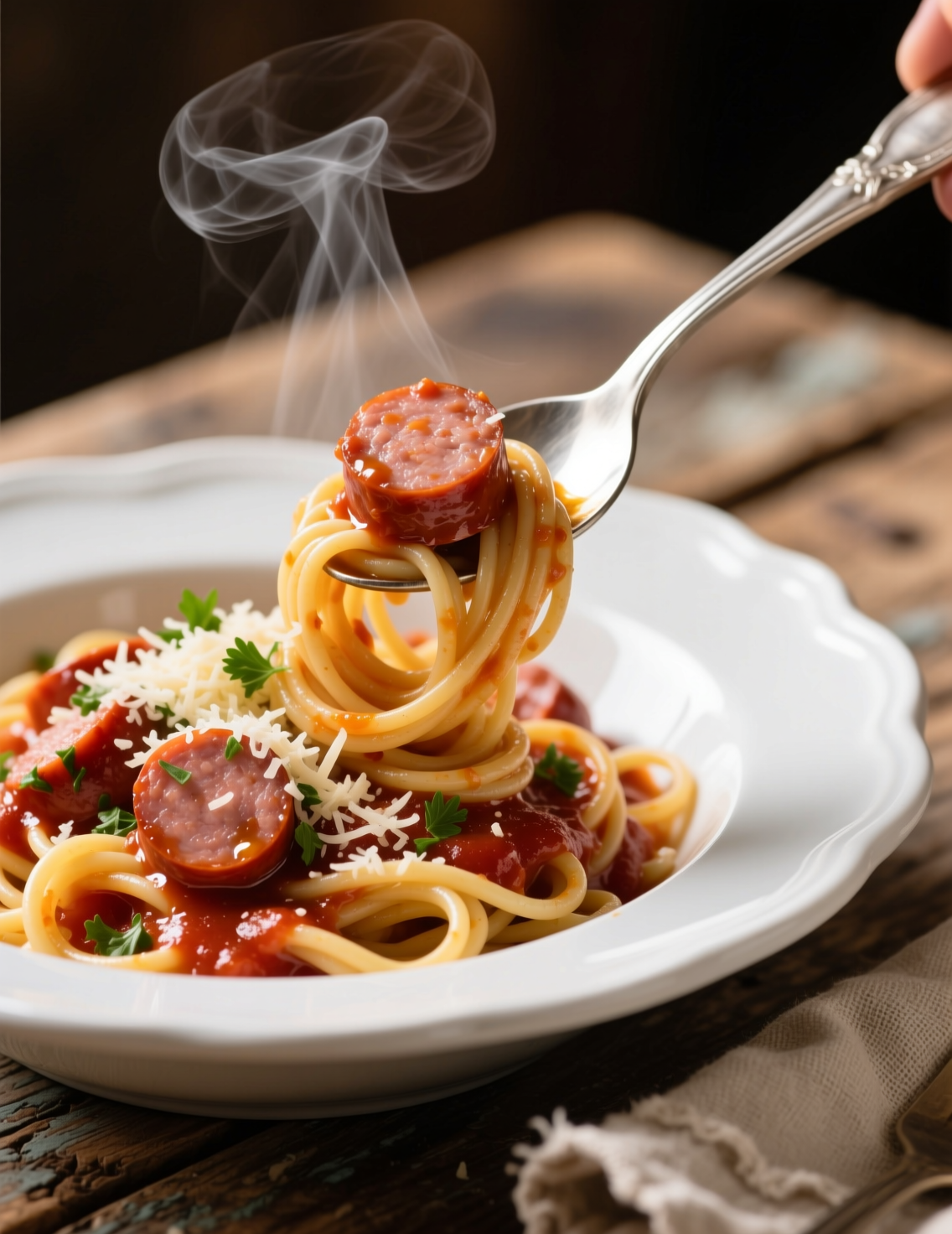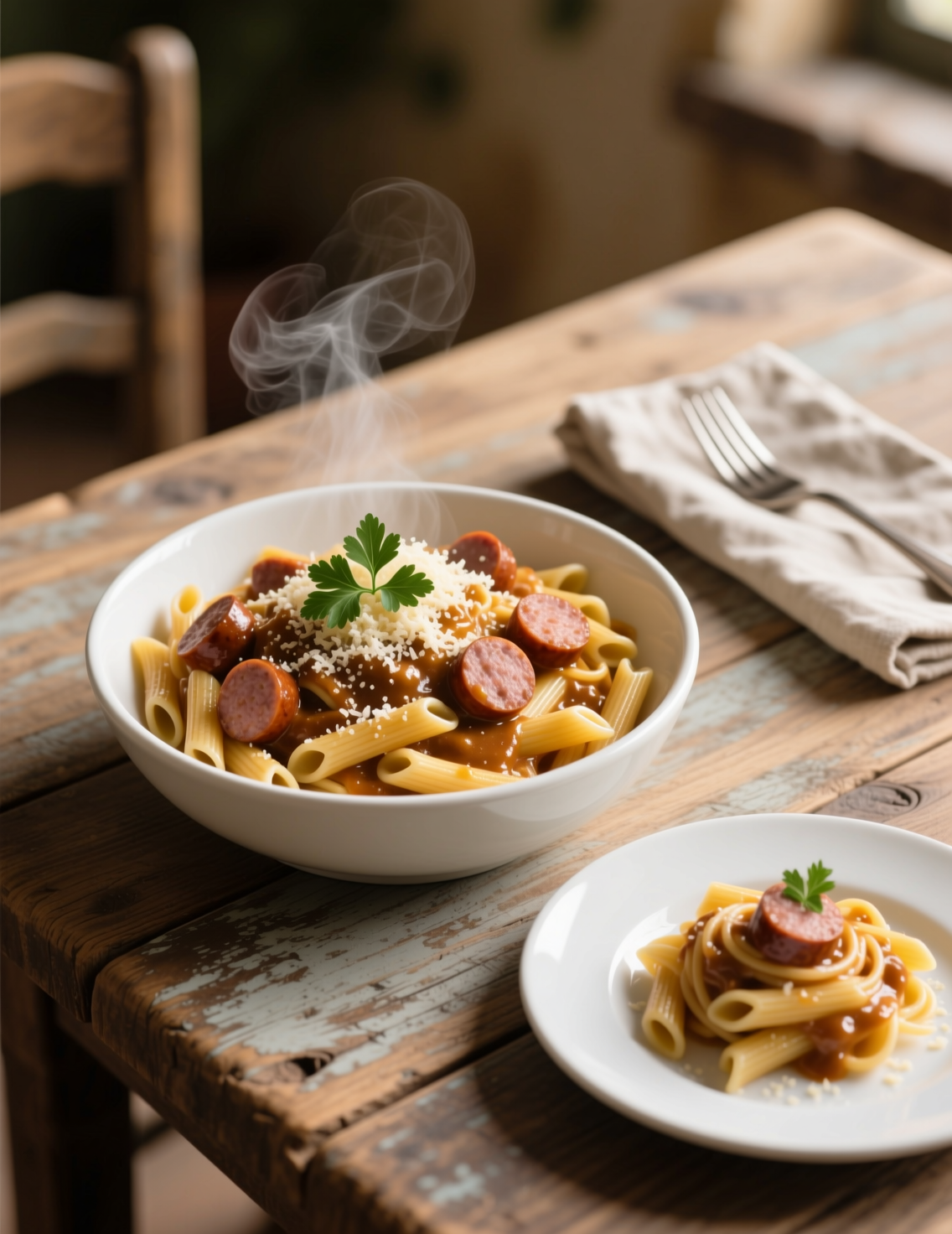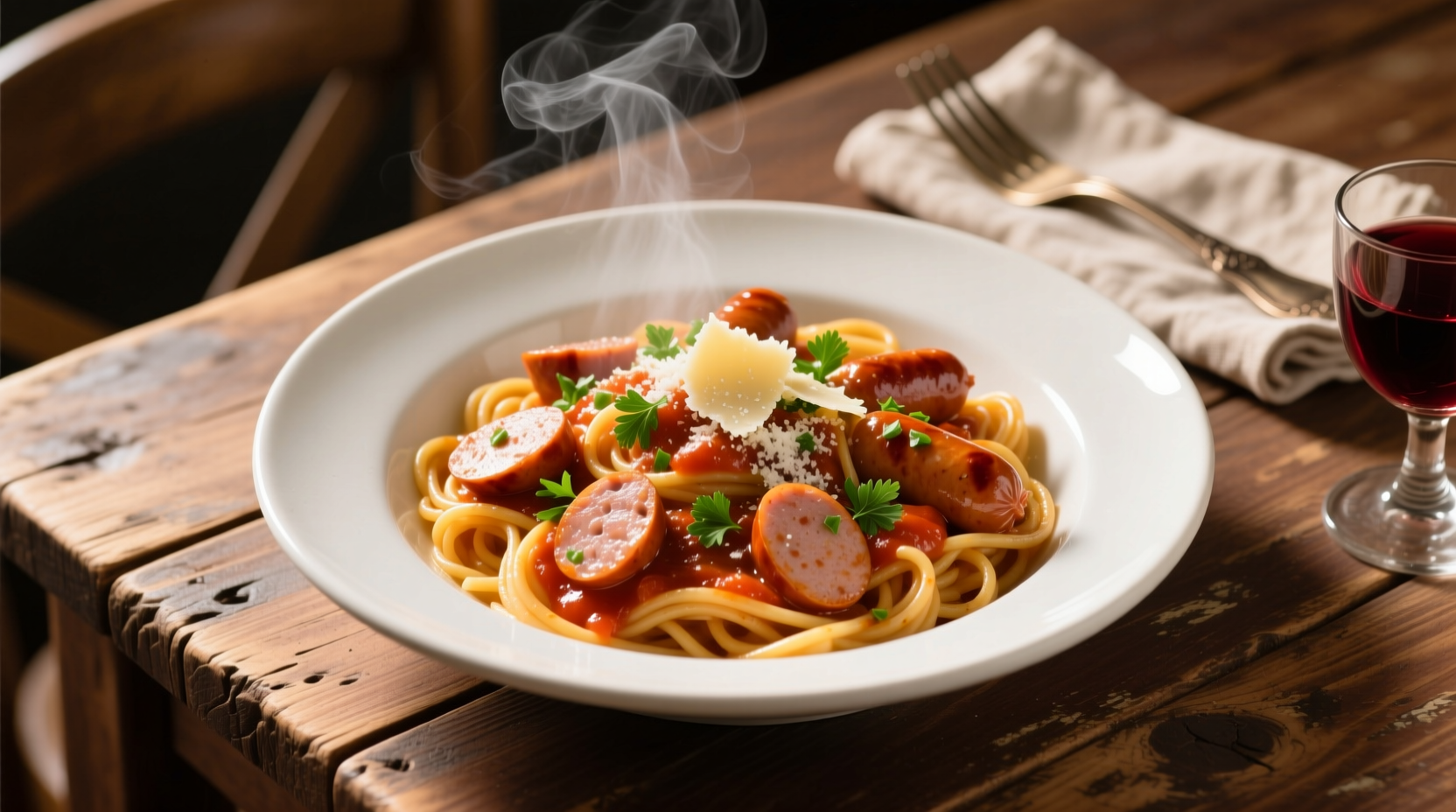Nothing hits the spot quite like pasta. But let’s be honest, sometimes we’re short on time, and that’s where this 30 Minute Sausage Pasta Recipe comes in. It’s fast, it’s hearty, and it scales perfectly for 6 servings. You get layers of flavor without babysitting the stove for hours. If you’re a cooking professional or just a home chef looking for efficient meals, this one’s worth dissecting.
Why Sausage Works So Well in Pasta
Sausage brings fat, spice, and umami. It’s more than just protein; it’s a flavor carrier. Italian sausage, for example, has fennel and paprika which dissolve into sauces differently than plain ground meat. You get instant depth. Research shows fat is crucial for flavor perception, making sausages an underrated secret weapon in weeknight pasta.
Using the right sausage matters. Fresh, uncooked sausages release fat slowly, giving you a natural sauce base. Pre-cooked or smoked sausages can alter texture and salt balance. For professionals, this is a key point: controlling moisture and fat content affects the emulsion of your pasta sauce.
Ingredients You’ll Need
For 6 servings, prep the following:
- 1 lb (450g) Italian sausage, casing removed
- 12 oz (340g) penne or rigatoni
- 2 cups cherry tomatoes, halved
- 1 medium onion, finely chopped
- 3 cloves garlic, minced
- 1 cup heavy cream or half-and-half
- ½ cup grated Parmesan
- ¼ cup fresh basil, chopped
- 2 tbsp olive oil
- Salt and pepper to taste
- Optional: crushed red pepper flakes for heat
Every ingredient serves a purpose. Tomatoes add acidity, sausage brings fat, cream softens, and basil lifts. Professionals will note the balance between acid, fat, and aromatics—this is how you prevent a flat pasta dish.

Step-by-Step Cooking Technique
Timing is everything in a 30-minute recipe. Professionals often multitask, so start pasta water first. Salt it like the sea; this seasons the pasta internally. While water heats, prep your sausage and vegetables.
Heat olive oil in a large skillet over medium-high. Add sausage and brown, breaking it up with a spoon. Browning isn’t just color; it’s Maillard reaction magic. That’s flavor chemistry right there.
Once browned, toss in onions. Sweat them until translucent, about 3–4 minutes. Garlic follows—don’t let it burn. Burnt garlic equals bitter. Professionals always cook aromatics in stages; it’s subtle but crucial.
Add cherry tomatoes. Stir and cook until they start to blister. This releases juices that mix with sausage fat. Deglaze if needed with a splash of pasta water. You’re creating a semi-emulsion, no fancy techniques required.
Meanwhile, pasta should be al dente—cook it for 1–2 minutes less than package instructions. Drain, reserving ½ cup of pasta water. That starchy water is a secret weapon for sauce cohesion.
Return pasta to the pan, add cream, Parmesan, and a bit of reserved water. Toss aggressively. The goal is to coat every piece evenly. This is where professionals pay attention: texture matters. The sauce should cling, not pool.
Finish with fresh basil and adjust seasoning. Basil should go in at the end; heat destroys volatile aromatics. A pinch of red pepper flakes can brighten the dish.
Common Mistakes to Avoid
One, overcooking sausage. That leads to dryness and loss of fat, ruining your sauce. Two, skipping the reserved pasta water. Without it, cream sauces often look clumpy or thin. Three, adding basil too early. Heat kills its aroma; you lose that fresh note.
Another subtle mistake is using low-fat dairy. Creaminess depends on fat content. Professionals will argue that even a splash of half-and-half versus heavy cream changes mouthfeel drastically. It’s science.
Flavor Balancing Tips
You can taste, but knowing why helps. If sauce is too acidic, a pinch of sugar tames tomatoes. Too fatty? Lemon juice brightens. Salty? Pasta water helps balance. Professionals adjust incrementally—small tweaks yield perfect equilibrium.
Texture also counts. Sausage should be tender, tomatoes slightly soft but not mush, pasta al dente. Mouthfeel influences perception of flavor more than we admit. Research confirms texture changes sweetness and umami perception.
Serving Suggestions
This pasta pairs well with crisp salads—arugula with lemon vinaigrette or simple greens with olive oil. Bread? Always. Garlic bread or toasted baguette completes the meal.
Wine? A medium-bodied red like Chianti works wonders. For non-alcoholic, sparkling water with lemon cleanses the palate. Presentation matters even in casual meals. Professionals know humans eat with their eyes first.
Emerging Trends in Pasta Dishes
30-minute meals are more popular than ever. Busy professionals and home cooks demand fast, flavorful dishes. Sausage pasta hits all criteria: minimal prep, protein, complex taste.
Plant-based sausages are also emerging. They mimic fat content using coconut oil or pea protein, allowing vegetarians to enjoy similar textures. Experimenting with spice blends is another trend. Smoky paprika or chili-infused sausages add new flavor dimensions.
Scaling Up for 6 Servings
Scaling requires careful math. Pasta doubles predictably, but sauce ingredients need balance. Professionals often use weight measurements over volume to ensure consistency. For instance, 1 lb sausage, 12 oz pasta, and 2 cups cream yield six perfect servings.
Cookware matters too. A larger skillet ensures even browning; crowded pans steam instead of sear. Stirring frequency is important—too much agitation can break pasta, too little and sauce sticks. It’s a fine dance.
Expert Insights on Efficiency
You can save 5–10 minutes with pre-chopped onions or garlic paste. Some chefs prefer using cherry tomatoes over canned crushed for texture variation. Browning sausage first prevents meat from stewing in its own water, keeping flavors concentrated.
Timing is a science. Professionals often measure out ingredients in prep bowls—mise en place. Even minor deviations in sequence affect final taste and texture. This method reduces mistakes in a fast 30-minute workflow.

Nutrition and Dietary Notes
Sausage pasta isn’t just indulgent; it can be balanced. Using whole wheat pasta adds fiber. Leaner sausages reduce saturated fat without compromising flavor. Cherry tomatoes provide antioxidants, basil adds vitamins. You can modify cream with half milk and half cream to cut calories slightly.
Portion control is key. A typical serving contains around 550–600 calories with standard ingredients. Six servings provide ample energy for a family meal or meal prep. Professionals consider caloric distribution when planning menus for clients.
Common Variations
Swap penne for rigatoni or farfalle; sauce clings differently. Add mushrooms or bell peppers for umami and color. For spicy lovers, increase red pepper flakes or use hot Italian sausage. Even a splash of white wine in the tomato-saute stage elevates the dish.
Seafood sausage is another interesting twist. It pairs beautifully with a light cream sauce, offering a modern take. Experimentation is key—flavors and textures can be manipulated without sacrificing speed.
Kitchen Equipment That Makes a Difference
A large non-stick skillet or heavy-bottomed pan prevents sticking and uneven browning. A pasta pot with strainer insert saves time. Sharp knives for prep reduce damage to aromatics and vegetables. Professionals often emphasize tools—time saved in prep translates to flavor perfection.
Troubleshooting
Sauce too thin? Add more Parmesan or reduce briefly on low heat. Pasta sticking together? Toss with reserved pasta water. Sausage dry? Ensure it wasn’t overcooked initially. Small adjustments keep the 30-minute promise intact.
Why This Recipe Works for Professionals
It combines speed, technique, and flavor management. You practice multitasking, temperature control, and flavor layering—all essential professional skills. It’s a simple dish but demands awareness, making it an excellent study for chefs looking to hone efficiency.
Conclusion
This 30 Minute Sausage Pasta Recipe for 6 Servings is more than a weeknight dinner. It’s an exercise in flavor science, timing, and texture balance. By following these techniques, professionals and home chefs alike can deliver a meal that’s fast, flavorful, and consistent. Remember the details—browning, reserved pasta water, timing, seasoning—and the result will impress every time.
Takeaways: control fat, manage acid, respect aromatics, and use pasta water wisely. Even in 30 minutes, you can achieve a dish that’s complex, balanced, and utterly satisfying.
FAQs
What type of sausage is best for this recipe?
Italian sausage, either sweet or spicy, works best for flavor and fat balance.
Can I use pre-cooked sausage?
Yes, but adjust seasoning and reduce fat content in the pan.
What pasta works best with sausage?
Penne, rigatoni, or farfalle are ideal for holding the sauce.
Can I make this recipe vegetarian?
Use plant-based sausage and skip or substitute cream with a dairy alternative.
How long does it take to cook?
Approximately 30 minutes from start to finish.
Can I prepare this in advance?
Yes, cook pasta and sausage separately, then combine when reheating.
Can I freeze leftovers?
Yes, but cream sauces may separate slightly when thawed.
How do I prevent pasta from sticking?
Reserve pasta water and toss pasta immediately after draining.
Can I make it spicier?
Add crushed red pepper flakes or use hot Italian sausage.
What wine pairs with this dish?
A medium-bodied red like Chianti complements the flavors well.
Can I substitute heavy cream?
Half-and-half works, but the sauce will be slightly less rich.
How do I keep the basil fresh?
Add it at the very end to preserve aroma and flavor.
Can I use canned tomatoes instead of cherry tomatoes?
Yes, but fresh cherry tomatoes provide better texture and sweetness.
How do I make the sauce creamier?
Use more Parmesan and a splash of reserved pasta water to emulsify.
Is this recipe suitable for meal prep?
Yes, it reheats well and serves 6 portions efficiently.

Mariana is a passionate home cook who creates delicious, easy-to-follow recipes for busy people. From energizing breakfasts to satisfying dinners and indulgent desserts, her dishes are designed to fuel both your body and hustle.
When she’s not in the kitchen, she’s exploring new flavors and dreaming up her next recipe to share with the Foodie Hustle community.

